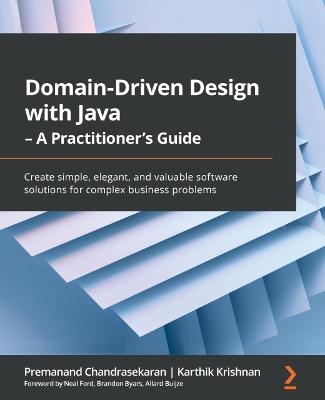
Domain-Driven Design with Java - A Practitioner's Guide
Packt Publishing Limited (Verlag)
978-1-80056-073-4 (ISBN)
Adopt a practical and modern approach to architecting and implementing DDD-inspired solutions to transform abstract business ideas into working software across the entire spectrum of the software development life cycle
Key Features
Implement DDD principles to build simple, effective, and well-factored solutions
Use lightweight modeling techniques to arrive at a common collective understanding of the problem domain
Decompose monolithic applications into loosely coupled, distributed components using modern design patterns
Book DescriptionDomain-Driven Design (DDD) makes available a set of techniques and patterns that enable domain experts, architects, and developers to work together to decompose complex business problems into a set of well-factored, collaborating, and loosely coupled subsystems.
This practical guide will help you as a developer and architect to put your knowledge to work in order to create elegant software designs that are enjoyable to work with and easy to reason about. You'll begin with an introduction to the concepts of domain-driven design and discover various ways to apply them in real-world scenarios. You'll also appreciate how DDD is extremely relevant when creating cloud native solutions that employ modern techniques such as event-driven microservices and fine-grained architectures. As you advance through the chapters, you'll get acquainted with core DDD's strategic design concepts such as the ubiquitous language, context maps, bounded contexts, and tactical design elements like aggregates and domain models and events. You'll understand how to apply modern, lightweight modeling techniques such as business value canvas, Wardley mapping, domain storytelling, and event storming, while also learning how to test-drive the system to create solutions that exhibit high degrees of internal quality.
By the end of this software design book, you'll be able to architect, design, and implement robust, resilient, and performant distributed software solutions.
What you will learn
Discover how to develop a shared understanding of the problem domain
Establish a clear demarcation between core and peripheral systems
Identify how to evolve and decompose complex systems into well-factored components
Apply elaboration techniques like domain storytelling and event storming
Implement EDA, CQRS, event sourcing, and much more
Design an ecosystem of cohesive, loosely coupled, and distributed microservices
Test-drive the implementation of an event-driven system in Java
Grasp how non-functional requirements influence bounded context decompositions
Who this book is forThis book is for intermediate Java programmers looking to upgrade their software engineering skills and adopt a collaborative and structured approach to designing complex software systems. Specifically, the book will assist senior developers and hands-on architects to gain a deeper understanding of domain-driven design and implement it in their organization. Familiarity with DDD techniques is not a prerequisite; however, working knowledge of Java is expected.
Premanand Chandrasekaran is a technology leader and change agent, with a solid track record of leading large technology teams and helping businesses deliver mission-critical problems while exhibiting high internal and external quality. In the past two decades, he has had the pleasure of helping a variety of clients and domains, including financial services, online retailers, education, and healthcare startups. His specialties include technical innovation, architecture, continuous delivery, agile/iterative transformation, and employee development. When not fiddling with his trusty laptop, he spends time cutting vegetables, cooking, playing video games, and analyzing the nuances of the game of cricket. Karthik Krishnan is a technology leader with over 25 years of experience in designing and building large-scale enterprise solutions across financial and retail domains. He has played numerous technical roles in leading product development for major financial institutions. He is currently serving the role of Technical Principal at Thoughtworks. He is passionate about platform thinking, solution architecture, application security and strives to be known as a coding architect. His most recent assignment entailed leading a large technology team helping their clients in their legacy modernization journey with Cloud. When not working, he spends time practicing playing tunes on his musical keyboard.
Table of Contents
The Rationale for Domain-Driven Design
The Mechanics of Domain-Driven Design
Where and How Does DDD Fit?
Domain Analysis and Modeling Using EventStorming
Implementing Domain Logic
Implementing the User Interface - Task-Based
Implementing Queries
Implementing Long-Running Flows
Integrating with External Systems
Beginning the decomposition journey
Decomposing into finer-grained components
Beyond Functional Requirements
| Erscheinungsdatum | 25.08.2022 |
|---|---|
| Verlagsort | Birmingham |
| Sprache | englisch |
| Maße | 75 x 93 mm |
| Themenwelt | Informatik ► Programmiersprachen / -werkzeuge ► Java |
| Mathematik / Informatik ► Informatik ► Web / Internet | |
| ISBN-10 | 1-80056-073-7 / 1800560737 |
| ISBN-13 | 978-1-80056-073-4 / 9781800560734 |
| Zustand | Neuware |
| Haben Sie eine Frage zum Produkt? |
aus dem Bereich



